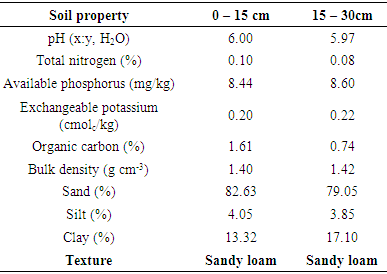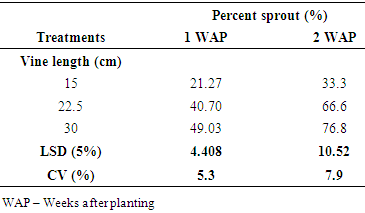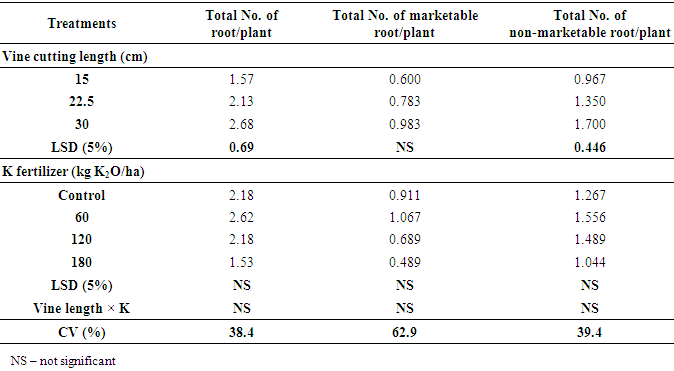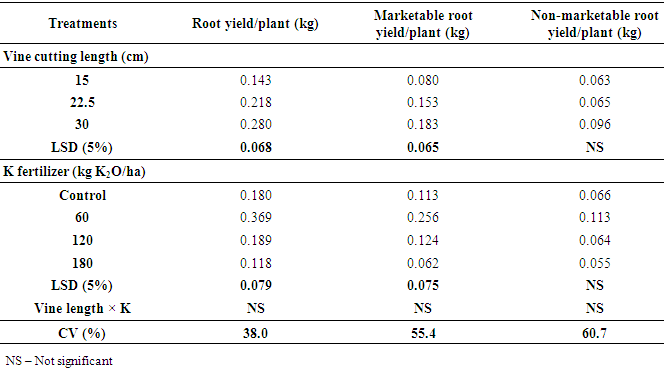-
Paper Information
- Next Paper
- Paper Submission
-
Journal Information
- About This Journal
- Editorial Board
- Current Issue
- Archive
- Author Guidelines
- Contact Us
International Journal of Agriculture and Forestry
p-ISSN: 2165-882X e-ISSN: 2165-8846
2017; 7(4): 88-94
doi:10.5923/j.ijaf.20170704.02

Effect of Vine Cutting Length and Potassium Fertilizer Rates on Sweet Potato Growth and Yield Components
G. Dumbuya1, J. Sarkodie-Addo2, M. A. Daramy3, M. Jalloh4
1Sierra Leone Agricultural Research Institute, Njala Agricultural Research Centre, Njala, Sierra Leone
2Department of Crop and Soil Sciences, Faculty of Agriculture, Kwame Nkrumah University of Science and Technology, Kumasi, Ghana
3Sierra Leone Agricultural Research Institute, Rokupr Agricultural Research Centre, Rokupr, Sierra Leone
4Sierra Leone Agricultural Research Institute, Kenema Forestry and Tree Crops Research Centre, Kenema, Sierra Leone
Correspondence to: G. Dumbuya, Sierra Leone Agricultural Research Institute, Njala Agricultural Research Centre, Njala, Sierra Leone.
| Email: |  |
Copyright © 2017 Scientific & Academic Publishing. All Rights Reserved.
This work is licensed under the Creative Commons Attribution International License (CC BY).
http://creativecommons.org/licenses/by/4.0/

A factorial field experiment was carried out during the minor season of 2014 to evaluate the effect of vine cutting length and potassium fertilizer on the growth and yield components of the sweet potato variety Okumkom. The treatments comprised three vine cutting lengths (15, 22.5 and 30 cm) and four rates of potassium fertilizer (0, 60, 120 and 180 kg K2O/ha) in the form of muriate of potash (60% K2O). These treatments were arranged in a Randomized Complete Block Design (RCBD) replicated three times. Each treatment received 30 kg N/ha in the form of urea (46% N). The greatest sweet potato growth and yield components were produced with 30 cm vine cuttings. The application of 60 kg K2O/ha of potassium fertilizer produced the longest vines, the highest number of leaves, branches, and tuber roots, as well as the highest marketable root yield.
Keywords: Sweet potato, Vine length, Potassium fertilizer, Growth, Yield components
Cite this paper: G. Dumbuya, J. Sarkodie-Addo, M. A. Daramy, M. Jalloh, Effect of Vine Cutting Length and Potassium Fertilizer Rates on Sweet Potato Growth and Yield Components, International Journal of Agriculture and Forestry, Vol. 7 No. 4, 2017, pp. 88-94. doi: 10.5923/j.ijaf.20170704.02.
Article Outline
1. Introduction
- Sweet potato is an important crop in sub-Saharan Africa (SSA) - the leaves are used as vegetable, and the root is boiled, fried as chips, baked, roasted or often fermented into food and beverages. It can therefore help to remedy hunger [1]. The orange-flesh sweet potato is considered as a complementary food approach for alleviating Vitamin A deficiency in SSA [2]. However, ignorance on the appropriate method of preparing the planting materials and optimum fertilizer rates for better growth and yield are major limiting factors for increasing sweet potato yield in SSA [3]. In Ghana, farmers use any type of cuttings which are available and convenient to handle with no distinctive manner of preparing them [4]. Some farmers plant short cuttings because they are easy to handle and more economical while others use very long cuttings obtained from already established fields. In other places, after harvesting the previous crop, the vines are left on the field to grow again without any organized propagation. The intermittent use of vines as planting material increases weevil infestations in sweet potato tubers and this drastically reduces the yield and quality of the crop [5]. It is, therefore, urgently necessary to identify the best methods of vine preparation for sweet potato cultivation. Potassium (K) is the most important nutrient in sweet potato production as its application increases yield by the formation of larger-sized tubers [6]. K is essential in the synthesis and translocation of carbohydrates from the tops to the roots [7], activates over 60 enzymes, promotes photosynthesis, controls stomata opening, improves the utilization of Nitrogen, promotes the transport of assimilates, and consequently increases crop yields. It plays a critical role in lowering cellular osmotic water potentials, thereby reducing the loss of water from leaf stomata, increasing the ability of root cells to take up water from the soil [8], and maintaining a high tissue water content even under drought conditions [9]. Although it is generally assumed that most tropical soils contain adequate amounts of K to sustain crop growth [10], K can still become a limiting nutrient under continuous cropping, especially with root and tuber crops. Root and tuber crops, like sweet potato, cassava, and Irish potato, have high demands for K because their leaves, vines, stems and tubers usually remove substantial quantities of K from the soil. It has been reported in Japan that a 13t/ha of cassava or sweet potato remove about110kg K2O/ha from the soil [11]. Even soils that are naturally rich in K can be depleted after successive cropping. Hence it is important to assess the response of sweet potato to K fertilizer in these soils.Therefore, this study was conducted to determine the appropriate vine cutting length and optimum rate of potassium fertilizer that will increase the growth and yield of sweet potato in the semi deciduous forest zone of Ghana.
2. Materials and Methods
2.1. Experimental Site
- The field experiment was carried out during the minor rainy season (September 2014 - January 2015) at the Plantation Section of the Crop and Soil Sciences Department, Kwame Nkrumah University of Science and Technology (KNUST), Kumasi to evaluate the effect of different vine lengths and potassium fertilizer rates on the growth and yield of sweet potato. Kumasi is located in the semi-deciduous forest vegetation zone of Ghana. It is about 356m above sea level on latitude 06° 43′′N and longitude 01° 33W [12].The rainfall pattern is bimodal, with major (Mid-March to July) and minor (September to November) rainy seasons. The average annual rainfall is 1422.4mm. In 2014, the average relative humidity varied from 83.88% (09 hours GMT) during the major and minor rainy seasons to 58.42% (15 hours GMT) during the dry season [13]. Annual average maximum and minimum temperatures were 31.59°C and 22.09°C, respectively but the mean daily maximum and minimum temperatures during the period of the experiment were 29.01°C and 21.32°C major season and 31.85°C and 22.34°C for the minor season. Total rainfall recorded during the experiment were 466.55mm (major season) and 317.85mm (minor season) and relative humidity varied from 77.84% (09 hours GMT) to 51.34% (15 hours GMT) (major season) compared to 83.67% (09 hours GMT) to 59.17% (15 hours GMT) (minor season) [13].
2.2. Experimental Layout
- The field trial was laid out as a 3 × 4 factorial experiment and treatment combinations were arranged in a Randomised Complete Block (RCBD) design with three replications. The factors studied were vine length (15, 22.5 and 30 cm) and potassium fertilizer rates (0, 60, 120 and 180kg K2O/ha) applied as muriate of potash.
2.3. Soil Sampling and Analysis
- Soil samples were collected at depths of 0 – 15cm and 15 – 30 cm for soil physico-chemical analyses. [14] and Modified Kjeldahl method described by [15] were used to determine organic carbon and total nitrogen, respectively. Exchangeable K was determined using the flame photometer method described by [16] and Bray-1 solution was used for extracting the available phosphorus [17]. Soil pH was measured in 1:2.5 soils to water suspension by the use of a pH meter and bulk density was determined using the formula of [18].
2.4. Land Preparation
- The land was manually cleared by slashing using a cutlass. Ploughing and harrowing were done with a tractor. The field was then levelled and plots were laid out using a meter rule and pegs. The plots were prepared into ridges using hoes, spades and garden lines. Each of the 36 plots measured 1.8 m × 5 m and had six ridges (1.8 m long and 0.3 m high). Spacing was 1.5 m between blocks and 1 m between plots and between ridges.
2.5. Vine Cutting Preparation and Planting
- Planting materials (Okumkom variety) were obtained from the Crops Research Institute (CRI). The vines were cut to different lengths – 15 cm with two nodes; 22.5 cm with four nodes and 30 cm with six nodes. The vines were planted on the ridges by inserting half of the length of the cuttings into the soil at an angle of about 45o at a spacing of 1 m × 0.3 m. Each ridge accommodated six plants giving a total of 36 plants per plot.
2.6. Agronomic Operations
- The different rates (0, 60, 120 and 180 kg K2O/ha) of potassium fertilizer were applied by side band placement at 3 weeks after planting (WAP); 30 kg N/ha in the form of urea (46 % N) was also applied to each plots at 3 weeks after planting. Hand weeding was done every 3 weeks until harvesting. Each plot was irrigated with three watering cans full of water every day before the cuttings sprouted but irrigation was done when necessary thereafter. Insect pests were controlled by applying 0.10 ml of Lambda master 2.5% E.C. (Lambda-Cyhalothrin, 9.8%) in 11 liters of water every 3 weeks using a Knapsack sprayer. The plants were harvested at 120 days after planting when the tubers had reached physiological maturity by scattering the ridges and removing the tubers from the soil with a hoe.
2.7. Data Collection and Analysis
- The percentage sprout for each plot was determined as the total number of cuttings that sprouted divided by the total number of cuttings planted multiplied by 100. Growth parameters (vine length, vine girth, number of branches and number of leaves per plant) were recorded. Vine length (cm) was measured on the longest vine of each of five tagged plants from the ground level to the apical bud of the plant using a meter rule. Vine girth from each of the five tagged plants was measured at 15 cm from the base of the plant with a Vernier caliper. The number of branches and leaves were determined by counting branches and leaves from each of the five tagged plants and the means calculated for each plot.Yield components (total number of roots harvested, root yield per plant, total number of marketable and non-marketable roots, marketable and non-marketable root yield per plant) were measured at harvest. The total number of roots was determined by counting the harvested roots from the five tagged plants in each plot. Root yield per plant was determined by weighing (kg) the harvested roots of five tagged plants on each plot using a weighing scale. Total number of marketable and non-marketable roots per plant was determined by counting the harvested roots from five tagged plants in each plot and the average numbers of marketable (medium to large) and non-marketable (small to very small) roots per plant were calculated.The data were subjected to Analysis of Variance (ANOVA) based on factorial using the GenStat statistical package. Treatment differences were determined using the Least Significant Difference (LSD) method at 5% level of probability.
3. Results
3.1. Soil Physico-chemical Properties
- The soil physico-chemical characteristics of the experimental site (Table 1) show that the texture of the soil was sandy loam. Available phosphorus (8.52 mg/kg) was moderately low and total nitrogen (0.09%) was low. Exchangeable potassium (0.21cmol/kg) was classified as moderate and the soil organic carbon was low (< 2%).
|
3.2. Percentage Sprout of Cuttings
- Percentage sprout of sweet potato cuttings as influenced by the length of the vines was highly significant (P < 0.001) for both sampling periods - it increased with increasing numbers of nodes. The 30 cm vine cuttings had the highest sprouting percentage of 49.03% and 76.80% for the first and second WAP, respectively. The lowest sprouting percentage was obtained from the 15 cm cuttings (Table 2).
|
3.3. Growth Parameters
- At 30 days after fertilizer application (DAF), vine cutting length and potassium fertilizer had significant effects on sweet potato growth. The highest vine length (Table 3) was associated with 30 cm cuttings and this was significantly higher than the other treatment effects between which there was no significant difference. The effect of 60 kg K2O/ha was significantly higher than that of other fertilizer rates and the control; 180 kg K2O/ha had a significantly lower effect than 120 kg K2O/ha. At 60 DAF, vine lengths for 30 and 22.5 cm cuttings were similar but greater than for 15 cm vine cuttings. Vine lengths were higher in 60 kg K2O/ha plots than in the control and 180 kg K2O/ha.
|
3.4. Yield Components
3.4.1. Total Number of Roots Harvested Per Plot
- The total number of roots per plant was significantly higher with 30 cm cuttings vine length than with 15 cm cuttings only but was not affected by the rate of potassium fertilizer application, although there were more roots in plots that received 60 kgK2O/ha (Table 4).
|
3.4.2. Total Number of Marketable and Non-marketable Roots Per Plant
- Neither vine cutting length nor potassium fertilizer rates affected the number of marketable roots (Table 4). The number of non- marketable roots was significantly higher with 30 cm cuttings than with 15 cm cuttings but was not affected by the rate of potassium fertilizer application.
3.4.3. Root Yield Per Plant
- The 30 cm cuttings produced significantly higher root yield than the15 cm cuttings only. Root yield was significantly higher with 60 kg K2O/ha than all other rates. All other treatment differences were not significant at 5% level of probability (Table 5).
|
3.4.4. Marketable and Non- marketable Root Yield Per Plant
- Marketable root yield was significantly more (P < 0.05) with 30 cm cuttings 15 cm cuttings and significantly higher with 60 kg K2O/ha than with all other rates. Neither the length of cuttings nor the rate of potassium fertilizer application significantly affected non- marketable root yield.
4. Discussion
4.1. Effect of Vine Length and Potassium Fertilizer Application on Growth Parameters of Sweet Potato
- The highly significant effect of vine cutting length on the percentage of cuttings that sprouted might be attributed to the higher number of nodes on the 30 cm compared to the 15 cm and 22.5 cm vine cuttings. Thus more nodes on the 30 cm cuttings were buried at planting leading to more root initiation for better establishment. Further, with more nodes, the number of buds increases and this serves as a source of growth for rooting and sprouting. This observation corroborates the report by [4] that cuttings with more (5 and 7) nodes attained 100% establishment earlier than cuttings with fewer (3) nodes. It also agrees with the finding by [19] and [20] that the percentage of cuttings established increased with an increase in the number of nodes per cutting in sweet potato, yam and cassava. In the present study, it was also observed that the cuttings began to establish at 1 WAP and, about 3 WAP, most cuttings were fully established. According to [21], cuttings require between 4 and 14 days to get fully established. The delay in the establishment of cuttings in our study might be due to the poor rainfall in the minor season during the period of the experiment.The higher values for growth parameters (vine length, vine girth, number of branches and number of leaves) associated with 30 cm cuttings could also be due to the greater number of nodes which might have enhanced the development of more roots, better and early establishment of cuttings, rapid vine development, more branches and more leaf production. [4] had earlier associated more branches with cuttings having more nodes (5 and 7) compared to those with fewer (3) nodes.The significant effect of potassium fertilizer rates on vine length, number of branches, vine girth and number of leaves supports the report by [6] of a significant increase in vine length, number of leaves and branches per plant following potassium fertilizer application. This effect might be attributed to the importance of K nutrition to sweet potato. K increases photosynthetic rates in the leaves and CO2 assimilation and facilitates carbon movement [22] and increasing the amount of potassium in the soil enhances nitrogen uptake by the plant. [23] and [24] explain that a shortage of potassium affects many metabolic processes (rate of photosynthesis, rate of translocation and enzyme systems) and thereby reduces plant growth. [23] reported a significant increase in the vegetative growth and yield of sweet potato in response to potassium fertilizer. [25] observed that K increased vine length, crop vigor, and leaf expansion, particularly at the early stages of growth. The current study found that growth parameters decreased above 60 kg K2O/ha, thus indicating that 60 kg K2O/ha is the optimum rate for this soil.However, potassium rates did not affect the number of leaves at 60 DAF, similar to the report by [26] who explained that this might be due to the bulking of the tuber roots. As tuber roots begin to bulk, more photosynthates are partitioned to the tuber for bulking at the expense of more leaf production [27].
4.2. Effect of Vine Length and Potassium Fertilizer Application on Yield Component of Sweet Potato
- The significant influence of vine cutting length on the total number of roots, roots yield and marketable roots yield could be explained by the higher number of nodes on the 30 cm cuttings which were buried and provided more points for tuber root initiation. According to [4], tuber initiation and bulking begin earlier on cuttings with more nodes than those with fewer nodes as a result of the early rapid growth which translated into higher roots yield and greater marketable yields. Vine cutting length did not significantly increase the total number of marketable roots and non- marketable roots in this study. However, there was a general trend towards an increase in the total number of marketable and non-marketable roots with an increase in the number of nodes per cutting. This might be due to the development of more roots on cuttings with more nodes. However, tubers on such plants are likely to be smaller due to competition among the roots for available nutrients and assimilate.Potassium fertilizer rates had significant effect on roots yield and marketable roots yield, but there was no significant increase on the total number of roots, total number of marketable and non- marketable roots and non- marketable roots yield. This showed that potassium fertilizer application increases the size of sweet potato roots but not the total number of tuber roots. The significant response shown by some of these yield components could be due to the beneficial effect of K in activating more than 60 enzymes which are necessary for essential plant processes such as energy utilization, starch synthesis, N metabolism and respiration [28]. The result agrees with the reports by [6] and [29] that potassium fertilizer increases the yield of sweet potato through the formation of large-sized tuber roots. [30] reported sweet potato yield increased with an increase in the rate of potassium fertilizer from 60 to 150 kg K2O. According to these authors, the greatest sweet potato yield was obtained with 150 kg K2O. In this study, however, all yield components decreased above 60 kg K2O/ha, suggesting that the 60 kg K2O/ha is sufficient for sweet potato yield in the study area. The low response of sweet potato to potassium fertilizer could be due to the initial moderate level of soil K (0.21cmol/kg). However, K could become limiting with continuous cultivation. It was also observed that the treatment with the greatest growth also produced the greatest yield, indicating a positive influence of plant growth on sweet potato yield.
5. Conclusions and Recommendations
- This study revealed that 30 cm-long sweet potato vine cuttings produced the greatest growth and yield and that the application of potassium fertilizer has the potential of increasing the growth and yield of sweet potato -the greatest growth and yield were obtained with 60 kg K2O/ha.For optimum sweet potato production, a combination of 30 cm vine cuttings and 60 kg K2O /ha is recommended for the semi-deciduous forest zone of Ghana. However, since the results obtained from this study were from one growing season, further studies are recommended to confirm them.
ACKNOWLEDGEMENTS
- The Authors wish to thank the West African Agricultural Productivity Program of Sierra Leone (WAAPP-SL) for financially support this work. We appreciate the effort of Dr. Olupomi Ajayi (Africa Rice Research Coordinator in Rokupr Agricultural Research Centre) for reviewing this article and Dr. Abdul Raham Conteh (Director, Njala Agricultural Research Centre) for his words of encouragement to push for more publications.
 Abstract
Abstract Reference
Reference Full-Text PDF
Full-Text PDF Full-text HTML
Full-text HTML



